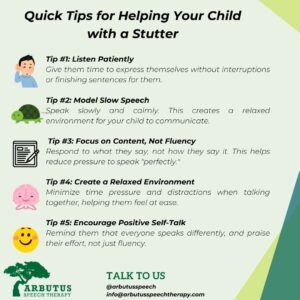It is an exciting milestone in a toddler’s life when they begin to communicate verbally. This new development involves learning vocabulary, speech sound production, combining words into sentences, and fluency – the smooth flow of words.
As a parent, you have an incredible opportunity to shape how your child communicates! Your little one is soaking up everything they hear from you, so it’s important to be mindful of the way you express yourself. This not only helps in nurturing their overall language development but can also be particularly beneficial for children who may be at a higher risk of developing a stutter during their preschool years. Let’s dive deeper into this fascinating learning process and explore some friendly tips on how to support your child’s communication skills!
The following are tips for how to be a great speaking model for your children. With this knowledge, you will be able to help improve your child’s fluency as they develop their language skills. First, let’s talk about what speech fluency is and how some children are more prone to fluency disorders (stuttering) than others.
What is Speech Fluency?
Fluency refers to the continuity, smoothness, rate, and effort in speaking. It’s very common to experience disfluency at times, even as an adult. Disfluent speech comes in different forms, like hesitation, stuttering (repeating sounds or parts of words), and the use of filler words (e.g. um, uh, like).
While disfluencies are common among everyone, there are such things as fluency disorders. A fluency disorder is a frequent interruption in the flow of speech, and can usually be accompanied by tension in the muscles of the face and neck, avoiding speaking, and so called ‘secondary behaviors’, such as lip tremors or rapid eye blinks. The most common fluency disorder is stuttering.
Stuttering comes in forms such as repetitions of sounds and syllables, prolongations of consonants, and speech blocks. Regardless, fluency disorders can be managed and improved with the right speech therapy. Knowing the commonalities of the language development process will help you better understand how to help your child.
High Risk for Stuttering?
There are a few factors that may increase a child’s risk of developing a persistent stutter, or a stutter that persists beyond the preschool years. For starters, boys are far more likely to stutter (and for it to be persistent) than girls. Stuttering is genetic, so if a parent, grandparent, or aunt/uncle stutter, it is more likely that your child will develop a stutter that may require therapy. If a stutter develops in the preschool years and lasts longer than 6 months, that is another risk factor for a stutter that may not go away. Remember, stuttering can be totally normal in the preschool years and very often a child’s stutter will go away as they age. However, if the above risk factors apply for your child, speak with a Speech-Language Pathologist. Preschool age is the only age when treatment for stuttering can reduce the stutter completely.
How to Help with Fluency as a Parent
Parents play an integral role in language development and are the key sources of learning for children. Speech clarity and fluency can improve with time and clear direction from parents. The following are a few tips for parents to consider when they want to improve their child’s speech fluency whether their child is at risk of stuttering or not!

Model a Slower Speaking Rate
Speaking at a slower rate and pausing regularly when you are talking with your child will not only help their comprehension skills, but also help with their speech fluency. When you don’t rush your speech, this gives your child a chance to understand each phrase and better assist their speech flow.
Reduce Background Noise
Background noise like having the TV on, music playing, or even others talking too loudly can be distracting for a child who is in the early stages of learning how to speak. Eliminate the noise and outside stressors that can put a strain on your child’s focus.
Practice Public Speaking
Stress and nerves are common influences on the fluency of speech. To get your child better acquainted, have them practice speaking in public. Encourage them to speak to others and engage in conversations outside the household. Engaging with people who aren’t their caregivers will expose them to a variation of conversations. As a result, the more practice your child gets around others, the more they can learn to improve their speech and become more confident speakers.
Be a Good Listener
Try to avoid finishing your child’s sentences if they get stuck. Allow them to finish their thoughts and solve the problem themselves before you intervene. It’s a courtesy we give to others, and the same goes for our children. This is a great way to encourage healthy, independent conversational skills.
Help Organize Thoughts
Help your child organize their stories and thoughts by gently probing for answers. Using questions like “who helped?” and “where did you go?” accompanied with “first” and “then” statements will help establish sentence structure. Reinforcing sentence organization by adding “Ok, so the first part of your story is… and then…” will help assist in fluency and structure.
Activities to Help Speech Fluency
There are many activities that you and your child can participate in to improve their speech fluency. Be sure to speak face-to-face with your child and make eye contact. Giving them your full attention will let them know they have time to get their message across and that you are actively listening. Additionally, reduce the number of questions you ask them and prioritize taking turns speaking. Asking too many questions makes your child feel they are on the spot, and taking turns will allow everyone in the conversation to feel it’s a safe speaking environment.
Making a start
The best way to improve speech fluency is to allow your child the time they need each day to practice their speech, while also demonstrating a great example in your own speech daily. Show that you enjoy talking with your child and reinforce your child’s willingness to engage in conversation. Speaking confidently and creating a safe learning environment will help your child improve language development skills. If you feel your child needs more assistance in fluency, get in touch with Arbutus Speech Therapy. We are here for you and can connect you with the resources and professionals to help.
Sources:

